Terra Sigillata.
Testing the dug Kunda and Laheema clay as glazes. Coating bisque fired white stoneware (high firing clay) with thin low firing clay slips results in the low temperature clays melting and having the possibility of creating smooth glazes made purely of clay.
Applying slip to clay bodies to create this shiny finish is a technique referred to as terra sigillata. This term also carries other meanings. One of which being as a medieval medicinal earth. Studied in this time certain clays from certain areas were said to prevent disease and protect against poison, once tested on two dogs. The dog that ate the tablet of clay survived the poisoning. The meaning of the term can be translated as ‘clay bearing little images’. There are also some definitions as ‘sealed earth’. Terra sigillata is also used in archaeology to refer to the large group of ware produced in Italy and Gaul during the Roman Empire which has a red slipped glossy surface.
Kunda clay slipped test before firing.
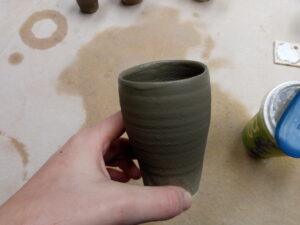
Laheema clay slipped test before firing.
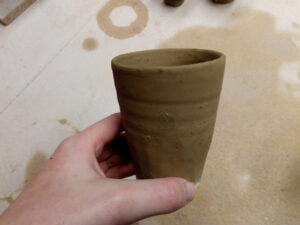
The colour of these raw clays applied on top of the fired thrown ware captures something I have been looking for. The pigments are strong, distinctive, however they are simultaneously purely earthy. The forms are carrying the movement of the wheel, they are finely made with crafted skill but they are not overworked, done quickly without hesitation. I did not know how these would come out, whether they would produce a smooth surface, one with a shine, how much they would melt and run off the vertical forms as no flux or other elements were in this coating. I seived the slips through as fine a seive as was in the studio however it still contained many imperfections. The clay would be left to it’s own devices, I made some small dishes to sit under these forms in the kiln to prepare to catch the molten run off expected.
Test results.
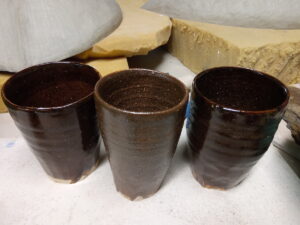
The centre cylinder above is the Laheema, the other two on either side are the Kunda clay.
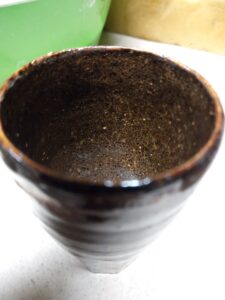

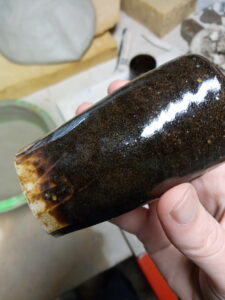
This smaller cylinder in the three images above is two layers of clay. It is the Laheema clay underneath the Kunda clay. This test produced the best result. It has the smoothest finish, there are minimal gritty grains. And it still carries this amazingly rich colour, also with a density of very small black speckles.
Below are further detail images of the tests. I am completely astounded by the glossiness of this clay when melted. The results are completely smooth. And the colour is beyond anything expected. The clay also did not run at all, it suspended itself. The Laheema clay has a smooth coarseness to it, the quantity of sand can be felt in it’s textured surface which still carries a very silver sheen. For food-safe functional ware all of these tests would be very usable. I will glaze the majority of my functional thrown ware in the double layer of Laheema and Kunda clay. I appreciate the mixing of these two clays, possibly from different geological times as the Laheema clay is not certainly Cambrian, to be part of one body. The two layers are fused together.
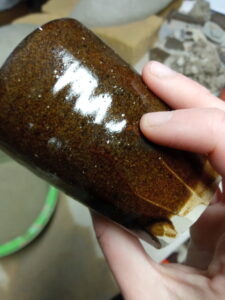
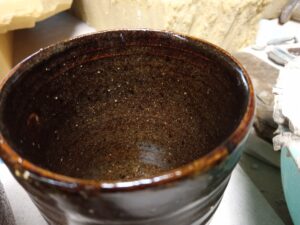
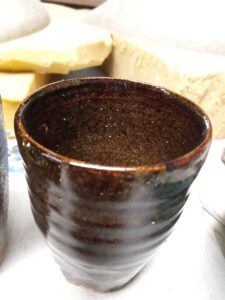
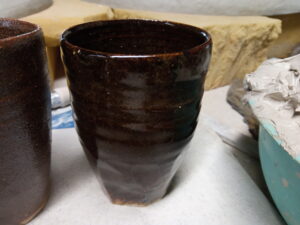
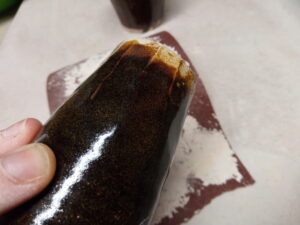

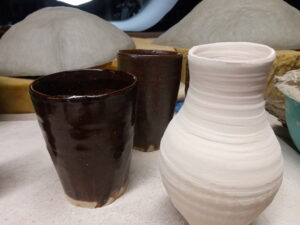
Bisque fired throwing next to the glazed tests. With the dry greenware sculptural forms waiting in the background. The different stages of production gather together on the work desk.
Throwing.
I have produced around 30 pieces of functional ware on the wheel. Below are images detailing the freshly thrown work through bisque firing and then glazing in the clay slips. My throwing has taken a long time to arrive at. It really requires me to be in a fully engaged and calm space. It is a full body and mind concentration, most definitely requiring a meditative certainty. I believe that I have captured what I wanted to in these forms. That will be sold at a market in a few weeks. They have a fluidity but the bases are also grounded. The groundedness I associate with being necessary after studying the geology of this place, and the fluidity is something to do with time, it’s movement and preservation. The forms are simple, no added handles, everything made from the movement of the wheel.
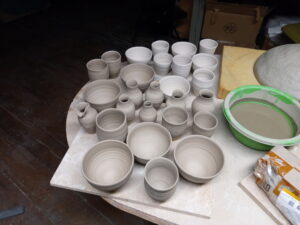


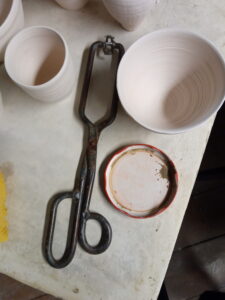
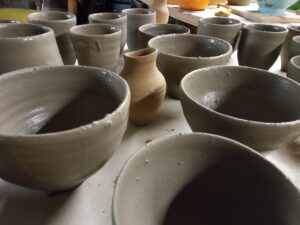

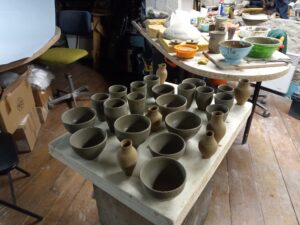
In producing this ware there is something similar in the process to the Kunda sculpture I have been pursuing. In the sense that the applied glaze is the found clay, which was dug up, to be activated, to be birthed. Then applied to a form, to a vehicle that provides it function of some sort, in this case being the white skeleton of the stoneware, which is the body that carries the finish, the skin. This is then fired, it undergoes a point of no return where the clay is vitrified and so can only decay in becoming grog, breaking and grinding into dust, grit. And so it is fossilised, it freezes and can withstand time to a certain extent.
The difference with this group, is that firstly they are a group. The Kunda sculpture is a pair. A pair of finely crafted forms being sited with an intention of sculptural metaphor. This group of functional ware is not made without sculptural sensitivity though. It has taken me a while to find the meeting point of function and expression in pottery in a way that is not overstating in any way that might be naive or unnecessary. I have been looking for a modesty, an understatement but also a clear movement, my hands, my feelings, my work within my environment that expresses the importance of things that I feel important. I think this only comes through repetition, through dedication, and the finding of that material and your relationship to it through craft approaches, through respect. And inevitably a lot of time, a kind of embodiment through process of material.
This group will be redistributed into people’s homes, what we see as the domestic, ‘separated’ from ‘nature’. I go out into the environment, collect, make, and then redistribute. These items will become part of people’s everyday. These objects were made with my immersion into understanding the landscape of Tallinn, of the North coast, of Estonia. Most of the people who will carry these works away with them also live within this same place. Maybe by having an object that is attempting to carry everything that is the expanse of this landscape, the one-ness of our environment, of us within nature, as natural beings, maybe that will somehow allow a few people to feel this connection with what is theirs and what is ours. And ours as in the earth’s and who we belong to, where we are.
These wares being part of people’s homes is different to the Kunda sculpture, being left in the river to flow down into the sea. One is an offering for us and I suppose the other is a surreneder or an offering back to a sacred place, to a place of importance, more than any of our small lives, eating away and mostly not adding.
All of these things are being carried around in different ways by different movements. Sometimes I wonder what exactly it is that allows all of these things that are constantly moving to start, where does it all come from, but I suppose it all comes from everything, and that’s how it continues.

